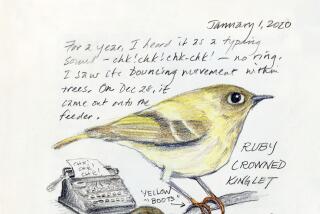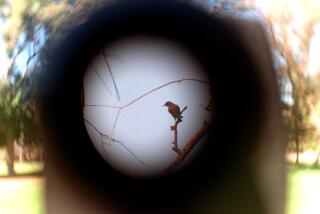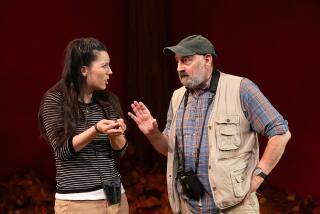Ah, the call of the birding field guides
Peterson Field Guide to Birds of North America
Roger Peterson
Houghton Mifflin: 532 pp., $26
--
Smithsonian Field Guide to the Birds of North America
Ted Floyd
Collins: 512 pp., $24.95
Picking a birding field guide is a little like picking a spouse. You have to find it attractive, of course, but that’s just not enough for the long haul. You need something smart, reliable. Something that won’t fail you when you need it most. Something compact enough to carry on a long hike but comprehensive enough to help you identify an unfamiliar bird when you’re 10 miles out on a trail with nobody to ask for help.
A good relationship with a field guide gets better over time. Yes, you learn its flaws -- how, for instance, the color on the indigo bunting illustration doesn’t quite match that flawless turquoise you see in the field. But you also become impressed by a good guide’s ability to convey the essence of a species with a few strokes of paint.
My field guide and I have been very happy in the eight years we’ve been together. David Allen Sibley’s “The Sibley Guide to Birds” came out right about the time I got serious about birding, and we’ve been together ever since. But that doesn’t mean I’ve lost my eye for other books. It’s Sibley who goes with me into the field, but back home I also spend time with other guides, including two new ones that have a lot to offer.
Long before Sibley, there was Roger Tory Peterson, the great man of 20th century birding. For decades, his field guides (“Western Birds” and “Birds of Eastern and Central North America”) were a required purchase for anyone serious about birds. For my money, however, they had two major flaws: First, there was no single guide to all U.S. birds, and since birds sometimes show up where they’re not expected, it’s nice to have all the North American species in a single volume. A bigger annoyance was that the distribution maps in the “Western Birds” guide -- which show where a bird is likely to be seen and in which season -- were all at the back of the book. Say you were in Oregon, and you spotted a bird that looked like the Cassin’s kingbird. You had to search in the back to find that spotting a Cassin’s in Oregon was highly unlikely.
“Peterson Field Guide to Birds of North America,” published 12 years after his death, combines the two guides into one, and has gone some way toward solving the map problem, putting tiny maps on the pages where the birds appear. For more detail, though, you still have to consult larger maps at the back of the book. The new guide is also supplemented online with a series of short video podcasts that are quite good at providing basic tips on birding and how to distinguish one species from another.
Even more appealing is the “Smithsonian Field Guide to the Birds of North America.” The guide uses photos rather than paintings, which has not always worked well in other guides. It’s tough to get a photo that captures the essentials, but this book succeeds. With tougher-to-identify species, it uses as many as five, showing birds in different plumages at different ages or times of year. The book comes with a DVD of songs and calls for 138 species. Being able to call up songs in the field on your iPod is great.
The truth is, you can’t go wrong with any of these field guides -- and half a dozen others as well. So how do you choose which one to buy? First, go outside. Spend an hour really watching the most common birds in your yard or a nearby park. Notice behaviors -- how, for instance, the scrub jay bobs its head up and down or how house finches call to one another in flight. Then go to a bookstore and sit down with a lapful of guides. Find the birds you’ve studied and look at their entries. Do the northern mockingbird wing stripes convey that bold flash of white you saw? Does the description of the scrub jay’s vocalization match what you heard in your yard?
People see and hear birds in many ways, and you want an author who sees things as you do. I’m glad to have the Peterson and Smithsonian guides in my library. But I’m the faithful type: Neither will likely tempt me from my Sibley.
--
Sue Horton is deputy editor of The Times’ California section.
More to Read
Sign up for The Wild
We’ll help you find the best places to hike, bike and run, as well as the perfect silent spots for meditation and yoga.
You may occasionally receive promotional content from the Los Angeles Times.







